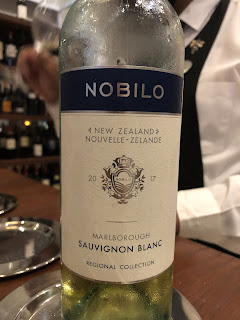And We Did Our Wine Tasting
As I said or at least implied yesterday, we were looking forward to our wine tasting, but a bit apprehensive. Hotel wine tastings are often bad and many times, I have found the people running them know far less than the students -- at least this student.
So, when we walked in, I was pleasantly surprised by Erick, the head Sommelier for the property. While not yet certified, more than anything that was due to the infrequency of testing opportunities in Mexico and the even further infrequency due to COVID. Apprently, there is a single CMS testing site in the country and CMS comes to Mexico City about every two years in normal times.
We were offered a choice of several different tastings and we chose the "International" one. The pours were advertised at 95 ml (about 3.5 ounces apiece) and I think that was fairly accurate. We were not cheated on the pours.
Leading off was a Nobilo Sauvignon Blanc from Marlborough in New Zealand, 2017 vintage. Honeztly, while I've had this wine a number of times and found it mediocre, I've never had it before with more than 4 years on it (remember, they harvest in the first half of the year in the southern hemisphere). Clean and crisp with grassy notes, this wine fermented entirely in steel tanks was quite pleasant. With just enough acidity to mature well, I could see this wine pairing extremely well with the fish tacos we have been living on for lunch in the pool.
Moving on to round number, we enjoyed a 2020 Le Poussin Rose from Whispering Angel in Languedoc not far from Provence. Made from a blend of Grenache, Syrah, and Cinsault, and produced by very short-term exposure to the skins, this wine had gentle grapefruit notes along with significant somewhat not yet ripe strawberry notes. I could imagine drinking this on a lazy summer weekend afternoon with a gentle breeze blowing and the sun just barely covered by wispy clouds. While not Provence, this area is really the home of Rose and this inexpensive one showed quite well.
For our third wine of this tasting, they normally serve a Meritage from Franciscan in Napa Valley. But, the hotel only has what it has at the time and they had sold out of that wine. What do they say? When in Mexico, drink Mexican.
Casa Madero is the oldest continually operating winery in North America having opened its doors so to speak in 1597. Located in the state of Coahulla to the west of Monterrey, this is an area characterized by very heavily clay based soil and massive diurnal temperature change. As Erick explained, during growing season, daytime highs are often in the range of 35-40C/95-104F, but the late afternoon and evening breezes cool things noticeably to between 5-10C/41-50F. This has the effect of increasing the acidity in the wines giving them potentially the ability to age longer and often pair better with food.
You will see on the bottle the large notation of 3V. I don't know if this is the law in Mexico, but when you see a bottle with a number followed by V, that indicates the number of different grapes used. In this case, they were Cabernet Sauvignon, Merlot, and Tempranillo -- all very warm weather grapes.
Another interesting tidbit was the designation of 13.7% alcohol by volume or ABV. As many people from the US know, there is a trend toward higher alcohol wine. And, in fact, there are at least thoughts that some US wineries inflate the ABV labeling of their wines. In Mexico, it is the opposite, however, as the higher the ABV, the higher the taxes they must pay.
Looking at the legs on this wine and then tasting it, no way this was less than 15% ABV. It was deep and dark, brooding you might say. Sadly, only about two years old and having been grown in an extremely warm season, the wine was a bit green on the palate, literally. But, I could easily see it pairing with the local beef and pork dishes made with the Mexican chilis.
Had I tasted this blind, it was so dark, I would have said Mourvedre. Of course, I would have been wrong, but that is usually the case.
We closed with the best wine of the bunch, at least by my standards. As I've written a number of times, the country of Hungary is broken into essentially four wine regions. In the coolest part of the country in the far northeast is Tokaji, an area known for its white grapes and particularly its luscious dessert wines. This wine produced by noted Spanish winery, Vega Sicilia did not disappoint. Loaded with honey, apricot, quince, and kumquat, this 2017 will age nicely and would be a great accompaniment to apple pie a la mode or for those people from the state of Georgia, a fried pie from the Varsity (I always wanted to get The Varsity into a wine blog).
All in all, I give sommelier Erick kudos and would recommend this tasting to anyone staying here at Paradisus Playa del Carmen.




Comments
Post a Comment
I'd like your feedback and questions.